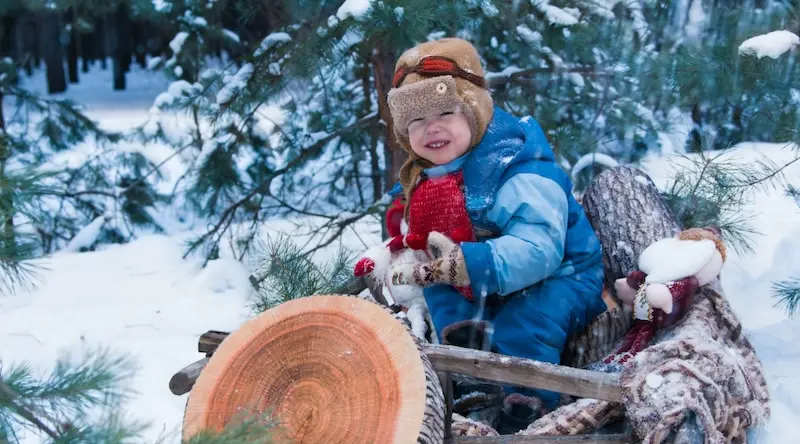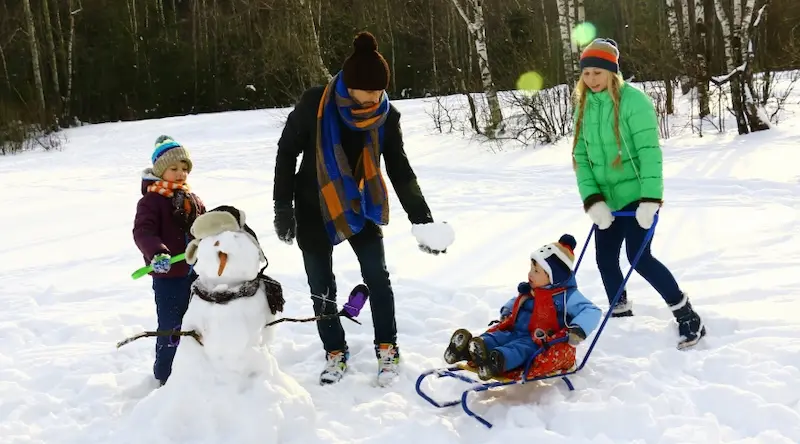settings
children
With Famly since
Despite our best efforts, winter’s settling in again.
You’ve started to see little puffs of steam following the children as they run across the playground. Each day gets a bit darker and a bit colder, which isn’t exactly what any of us needs. This all means that outdoor learning might not seem as easy as it did this summer.
You might feel like it’s time to call the children indoors, and pack up your outdoor learning for the season.
But not everybody sees things this way.
In Scandinavia, the cold and dark doesn’t mean it’s time to go inside — it just means it’s time to do things a little differently. Scandinavians have a knack for making the best of all seasons, even (or perhaps especially) when it’s not shorts weather. Up in the Nordics, bundling babies up for a nap in -5° weather is routine practice — so running winter outdoor learning with young children is nothing new.
Friluftsliv: Making the space and time for nature
Swedish, Danish and Norwegian all have the word friluftsliv. Literally translating to “free air life,” it speaks to the desire to connect with nature, to get the experiences we won’t find under a roof and four walls.
For young children, nature is where you’ll learn some of your most foundational life lessons. Here’s how researchers from Sweden’s Luleå University of Technology describe the core learning experience of friluftsliv:
“Friluftsliv is not about teaching and lecturing or being on excursions. But it involves a sort of education, learning the ways of yourself and the place in the more-than-human world and learning the ways of every creature and phenomenon you meet on your journey through life,” they write.
But don’t worry, you don’t need to get this by scaling a Norwegian glacier with your toddlers. One big part of friluftsliv is learning to enjoy nature in little sips, not just big gulps. You can get the benefits of friluftsliv from a trip to your local park, or to even in your garden. It’s all about how you approach it.

Keeping warm during winter outdoor learning
Right, onto the big question: How do you keep children warm during winter outdoor learning? Talk to a Dane, Swede or Norwegian about ugly weather, and you’ll inevitably hear their Scandinavian mantra: “There’s no such thing as bad weather, only bad clothes.”
Here are some of the most important ways to keep warm during winter outdoor learning:
- Help children dress for the weather. Wool sweaters and waterproof fabrics go a long way, and children should dress in layers, so that they can keep comfortable through the day. Safety vests and reflective strips are also useful for visibility, if it’s getting dark early where you are.
- Keep spare warm clothing on hand. It’s easy enough for a mitten to go missing in action, or for socks to get soaked through. You could coordinate with parents to help each child bring a change of clothes, or check in your local charity and secondhand shops to find some spare gear for anyone who needs it.
- Extra warmth never hurt anyone. Hand warmers, foot warmers, and rubber hot water bottles go a long way. Slip a hand warmer into children’s mittens, or help them zip the hot water bottle inside their jacket.
- Bring some warm treats along. Having special treats helps make winter outdoor learning a cozy, rewarding experience for children. An insulated thermos filled with tea or hot cocoa, or some warm porridge or applesauce is a sure hit when everyone needs to take a little break.
Jo Skone has been leading children in outdoor learning for over 30 years, rain or shine. As she sees it, preparing for the weather is a valuable way for young children to learn how to read the weather, take responsibility, and be prepared.
“It goes back to the Characteristics of Effective Learning: Resilience, being adaptable and flexible. You can give them responsibility by asking, ‘We’re all a bit chilly now, what can we do?’ And they come up with ideas, like let’s run around and play chase, let’s get a hat, let’s have a bonfire,” Jo says. “Of course, you show you care that they keep warm and comfortable, but this is a way to nudge them toward learning to recognize and solve their own problems.”
The big ideas
Keeping everyone moving
When you’ve got the little ones outside, you’ve got to keep things moving. It helps children keep warm and stay focused — they’ve got less tolerance for sitting around and listening when it’s chilly.
But to keep the momentum going, you’ve got to plan ahead. This means putting together a list of active things to do in any situation, so you’ve always got a suggestion when you feel a dip in the day’s momentum.
Here are some key ways to keep active during winter outdoor learning:
- Turn story time into pantomime time. Instead of sitting down to share a story, invite the children to get up and act it out with you. Bonus points for doing all the voices!
- Have a go-to game for running around. What could get children up and running about? A simple game of tag, capture the flag or a ball game are quick, easy ways to let everyone burn off a bit of steam and get a bit warm, if you’re feeling a lull in the action.
- Prepare a scavenger hunt in your surroundings. Who can find the most pinecones in five minutes? What about the coolest leaf? You can put together a simple scavenger hunt in the morning, and wheel it out whenever you think the group needs it.

Getting children on board with outdoor learning
Especially if the idea of getting bundled up for outdoor learning is a new one this year, children might not know what to think of it at first.
As research from the University of Tromsø in Norway suggests, the attitude we have toward winter has a real impact on how much we thrive. And children will look to you and the other adults as examples.
“If you stand around saying, ‘oh, it’s cold, and I’m uncomfortable,’ the children will pick up on that,” Jo says. “Instead, you should be modeling enthusiasm for being outdoors. You have to be comfortable and confident, because you can’t give what you haven’t got.”
But you’ve still got to be sensitive to how children are behaving. Winter outdoor learning shouldn’t be punishing — so if you’re noticing that the children aren’t quite feeling up to it, it’s alright to cut things short, take a break, or head in for the day.
“The bottom line is we want the children to be comfortable and enjoy themselves. After all, it’s an outdoor learning experience, not army survival training,” Jo says.
Clearing winter outdoor learning with the parents
But what about the grown-ups? For some people, the idea of their child being outside all day in the middle of winter might seem a bit risky.
The trick here is getting ahead of it all with good communication. Here are two big ways you can do that:
- Connect with parents ahead of time for an information session. Talk to them about why you’re doing outdoor learning during the winter, and what you’ll do to keep children comfortable and safe. You could bring up all the reasons that outdoor learning is great for children — and that it’s a safe option with regards to coronavirus precautions.
- Show parents that children are comfortable and happy. Jo uses Famly to send pictures and text updates to parents throughout the day. “The Famly platform is great for that, because it’s so fast. I just spend 30 minutes at the end of the day firing off photographs of children dressed warmly, sitting round a fire and having hot cocoa. That does a lot to make parents comfortable with the whole thing,” Jo says.

Planning: The key to winter outdoor learning
Winter outdoor learning doesn’t just happen by itself.
“When it’s done well, outdoor learning looks unplanned. But great learning happens when someone plans it, prepares it, and can be adaptable and flexible with the children,” Jo says. “You can’t leave it all to chance. I would never show up in the morning and see what happens. You’ve got to have some tricks up your sleeve for whatever the weather brings.”
Nobody starts out as an expert, so it’s okay to start small, and grow as you go. You can treat it just like indoor learning — if something’s going wrong, you should think about what you could tweak, or what you could prepare to make things run smoother. Especially when you’ve got to brave the elements, prep work is key — you become flexible when you’ve got a plan for every situation.
Finally, Jo explains, winter outdoor learning starts with you.
“If you see the value in it yourself, that’s your motivation and driving force.” Jo says. “The most important thing is to come prepared, but also be flexible toward your children’s needs. You want them to leave wanting more, rather than being glad it’s all over.”
Get 1000s of free EY activities
Want over 7,000 activities? See them in a free 14-day trial. Filter to target learning areas, age groups and topics, and get inspired.
Get started









